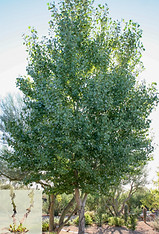
USU Extension offices list of invasive and/or difficult to grow trees in Iron County.
Green Ash
Fraxinus pennsylvanica
Green Ash was a very popular species in Utah for a long time. Green Ash will grow in many Utah locations. The problem with Green Ash is overpopulation. The result of having so many Green Ash trees in our urban forests is that most mature specimens have become infected with borers. The borers slowly consume the growing tissues of the trees, and eventually kill them. While this process takes place, the stems and branches of the trees tend to become brittle and fall out of the tree. Treatment for borers can be expensive and must be maintained over a period of many years. There are other species of Ash that are less susceptible to borer problems (White Ash, Blue Ash, Raywood Ash, and Flowering Ash) that should be considered before Green Ash.

All tree species have positive and negative traits. There are some species of trees that may be the only species that will grow under certain conditions. Some of the trees described below are listed as acceptable trees, but they do have some traits that can make them a nuisance in certain situations. There are some species of trees that have many negative traits that make them a poor selection for any site. These tree species will be discussed so that you might be better informed before you plant.
Russian Olive
Elaeagnus augustifolia
Russian Olives were imported to Utah decades ago because they can grow in almost any situation. This tree has proven that it can grow in even the worst circumstances. It is a very hearty tree that is very hard to kill once established. Russian Olive is also very successful at quickly populating any area where it might be growing.
Most people dislike Russian Olive because of its profuse and long thorns, its very numerous fruit, its pungent odor as it flowers in the spring, and its ability to quickly overtake any area where it may grow. Once established, Russian Olive can be very hard to eradicate because of its ability to sprout from roots as well as seeds that can last in the soil for several years. In some areas, Russian Olives are considered a noxious weed.


.jpg)



Siberian Elm
Ulmus pumila
Siberian Elm is the weed of the elm family. While most elm species are good hearty trees, Siberian Elm is a problem in the urban forest. Siberian Elm are prone to having weak wood, slime flow from bacteria, poorly attached branches, and producing amazing amounts of seeds. In many areas, Siberian Elm has become an invasive species and a noxious weed. Most people do not plant Siberian Elm; they are very talented at planting themselves. Even on the poorest sites, there are better selections than Siberian Elm.
Siberian Elm is not the same species as Chinese or Lacebark Elm. Siberian Elm is sometimes called Chinese Elm, make sure you know the difference. Chinese or Lacebark Elm is a very hearty species of elm that is highly recommended for many Utah sites. The bark and growth habit of Chinese Elm is very different from Siberian Elm and should not be confused as the same tree species.
Tree of Heaven
Ailanthus altissima
Invasive Species
Tree of Heaven, sometimes referred to as Sumac Tree, is considered a noxious weed and/or an invasive species in many areas. Tree of Heaven is a very rapid growing tree that can grow in almost any location. Tree of Heaven will produce thousands of seeds that will spread very quickly to many locations. There are many areas of the USA where Tree of Heaven are taking over native forests. Tree of Heaven tend to have weak wood, weak branches, and roots that grow near the surface. If you have a Tree of Heaven, you should remove it immediately and plant an acceptable species.
Poplar/Cottonwood Trees
Populus spp.
Poplar and Cottonwood trees are fast growing trees that love to be near water. Many Poplar trees can grow 5 feet or more per year. Many people choose to plant poplar trees so that they can have quick shade in their new landscapes. However, it is this rapid growth rate that contributes to the negative points of poplar trees.
Poplar and cottonwood trees are very short lived trees that have weak wood and poor structures. Most poplar trees, even cottonless forms, also can produce pollen and catkins that can be quite messy in the spring. Poplars, because of their love of water, tend to grow roots near or above the soil surface. Poplars will send up shoots from their roots profusely, especially in well irrigated landscapes. Because of their weak wood, poplars are prone to fall apart in storm events. Poplars may have use and windbreaks in rural areas or on farms. However, Poplars should not be included in a residential landscape.
Willow Trees
Salix spp.
All species of willow trees share the same negative traits. Most notable of these traits are very weak wood, rapid decay of the trunk and branches, and the habit of constantly dropping branches and stems. Willow trees are short lived trees that want to be very near water. People tend to choose willow trees because of their rapid growth rate. However, as with poplar and cottonwood, rapid growth results in some inherent problems. Willow trees have their uses, but residential and commercial landscapes should not be one of them.
